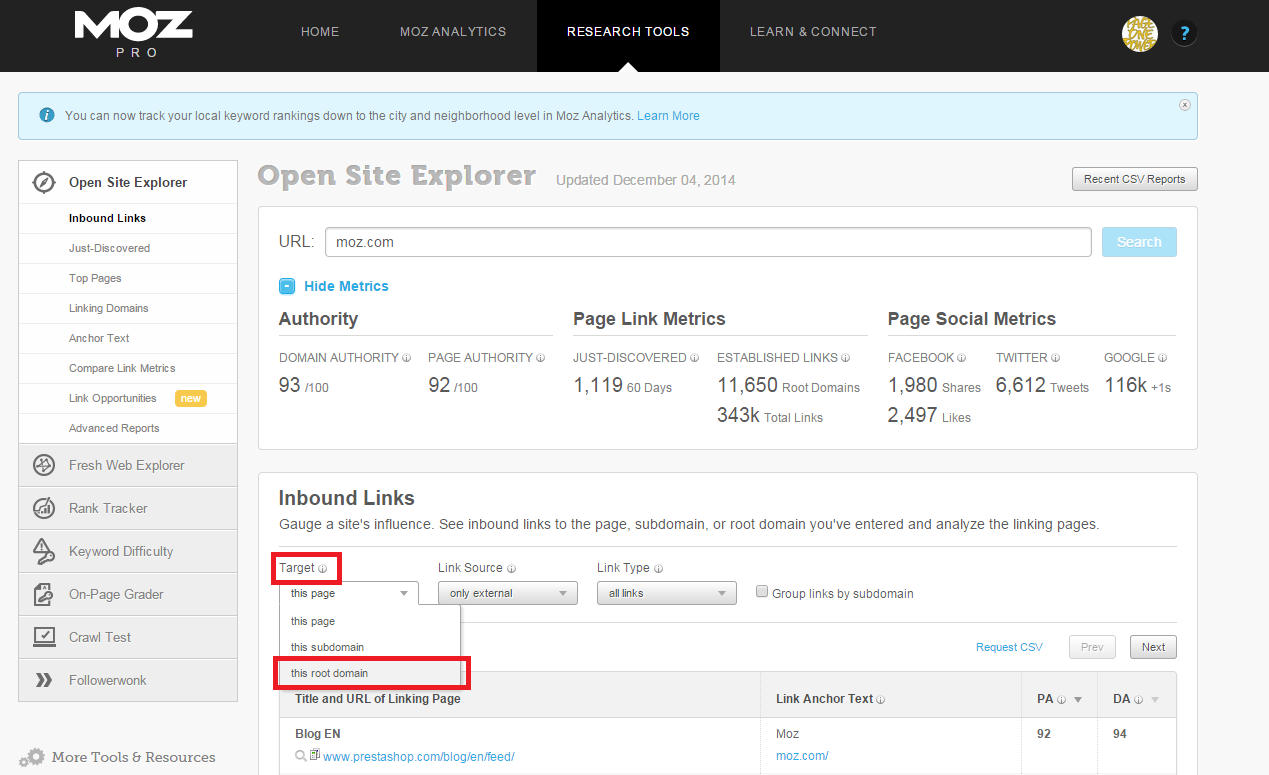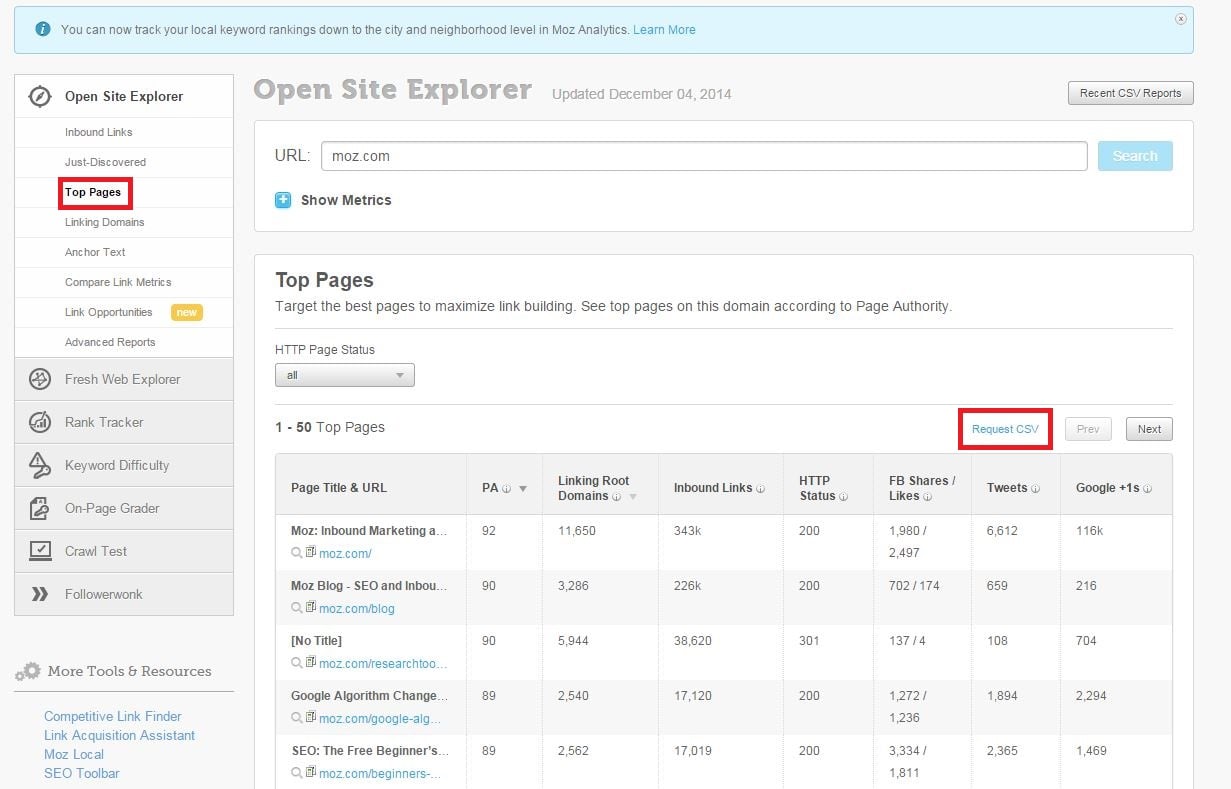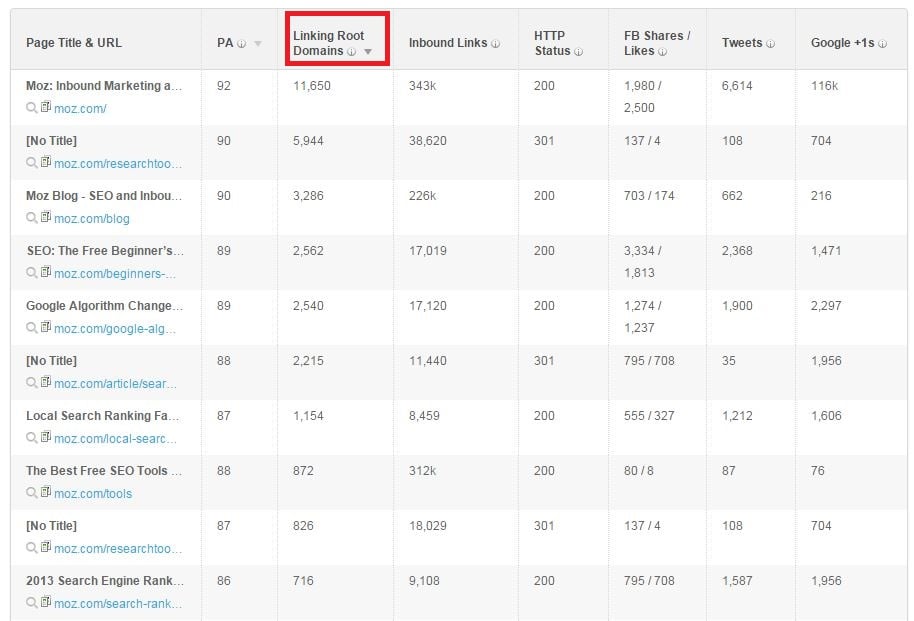Hello and welcome to another Tutorial Tuesday!
This week I’ll be sharing how to use Open Site Explorer to take a peek at our competitors’ top performing (in terms of links) content. This gives us a strategic idea of competitor content performance - both the good and the bad.
Backlink explorers offer a variety of insights directly into your competitor’s website. Because links are one of the primary online currencies, and directly influence search engine visibility, understanding which pages on your competitor’s website are heavily linked to provides insight into your niche and target audience.
As they say, information is power. We’ll use this information to inform our own content ideas, and vet which ones are likely to perform well. There's really no such thing as an original idea anyways - why not use your competitor's content as a jumping point to create new ideas for strategic content?
Let’s plug Moz’s own domain into Open Site Explorer (deliciously ironic, no?).
Step One: Examining the Root Domain in OSE
With Open Site Explorer your first step should always be filtering to the root domain, instead of just the page (which would be only the homepage as opposed to every page on the site).
This filters down a list of all the top performing pages on Moz’s entire domain, based upon Page Authority.
As with any tool, I recommend you look around for a bit to get a sense of the functions and potential data. The more you understand the inner-workings of a tool, the better you’ll be able to use it.
Step Two: Exploring Top Pages
Although filtering down to the root domain will list the top pages by Page Authority, moving over to “Top Pages” will give us even more data.
Bear in mind that all of this is downloadable as a CSV (highlighted), which will allow you to manipulate this data in Excel for even more insights and filtering. Better yet, you can combine other competitors’ data into a single excel sheet, allowing you to quickly examine content from a variety of competing websites.
For this tutorial however we’ll be sticking within OSE itself.
Here’s Moz’s top 10 pages, filtered by Linking Root Domains (default is PA):
Stated plainly, Moz’s top linked pages are:
- The homepage
- Open Site Explorer
- Moz’s main blog
- The Beginner’s Guide to SEO
- Google Algorithm Change History
- The 2013 search ranking factors page
- The 2013 local search ranking factors page
- SEO Tools page
- Moz Local
- The Beginner’s Guide to SEO Chapter 5: Keyword Research
There are five actual pieces of content ranking among their top ten pages:
- The beginner’s guide to SEO
- The Google algorithm change history
- The 2013 local search ranking factors piece
- The 2013 search ranking factors piece.
- Chapter 5: keyword research in the beginner's guide to SEO.
There are two pairs of content in that list which are nearly identical: the local and nonlocal search ranking factors content, both of which are surveys relying upon expert contributions, and the beginner's guide to SEO and Chapter 5 of the beginner's guide. Clearly we'll need to dig deeper.
Let's pull out Moz’s actual top 10 linked pieces of content (as opposed to pages):
- The beginner’s guide to SEO
- The Google algorithm change history
- The 2013 search engine ranking factors
- The 2013 local search engine ranking factors
- Chapter 5: Keyword Research
- Amazing Correlation Between Google +1s and Higher Search Rankings
- A Visual Guide to Keyword Targeting and On-Page SEO
- The Web Developer’s SEO Cheat Sheet 2.0
- New Title Tag Guidelines & Preview Tool
- How to Prepare for Author Rank and Get the Jump on Google
That’s just the top ten, filtered by linking root domains (how many unique websites are linking to the content) according to Moz’s own OSE. The dropoff is impressively gradual; many pieces of content have very similar performance in regards to root linking domains. Moz has a large stock of highly linked content.
Now comes the fun part: analyzing the content and brainstorming our own content ideas.
Step Three: Brainstorm Strategic Ideas
We have a few insights into Moz’s top performing pages now. Although it would be wise to go beyond the top ten, in this case we’re looking for a large creative project with heaps of potential.
If you really want to be strategic, you should combine multiple competitors and analyze heaps of content to get a clear picture of what works in your industry. For this tutorial though, we'll demonstrate the power of analyzing even the top ten performing pieces of content from a competitor.
Analyzing this content for our own purposes—creating linkable content on Linkarati—we want to think about commonalities across Moz's top performing content.
I see four types of content here:
- Comprehensive beginner guides designed to fully explain a concept
- Analysis into search rankings (core to the industry)
- How-tos designed to keep a user up to date on best practices
- Historical information examining past industry trends.
All of these have a single broad commonality: they’re resources for users unfamiliar with our industry, or people looking to learn more.
Our goal will be to create something similar, which will allow us to follow in Moz’s link wake, while making something uniquely our own and valuable in its own right.
Let’s use a specific example that came from analyzing Moz: Linkarati’s Google Manual Penalties Against Brand Names: A Timeline.
This piece of content was designed to be sort of the flip side of Moz’s Google algorithm change history. Our content shows when Google manually punished a large brand name, publicly. We felt this content would be valuable for four reasons:
- Insightful: demonstrates what causes Google to penalize a big brand, despite potentially negative publicity. (Good for beginners).
- Historical: shows Google’s evolution over time. (Good for those looking to learn more).
- Differing perspective: The fact that Google does punish large brands, despite SEOs’ perception of Google as pandering to large brands. (Good for those established in the industry).
- Unique: we couldn't find this content covered comprehensively anywhere else on the web.
Research showed no such resource (that we were able to find) had been created, so there was a content gap. Moz’s similar content showed the potential for links. And our own judgment deemed it valuable and worth creating. So, create it we did.
Take time to understand what’s working for your competitors. Especially those larger and more established than you. Then take those core concepts and apply them to yourself, and your content.
What interests you specifically in your industry? What interests your readers? What content doesn’t exist, but would meet the same criterion that is causing your competitors content to seemingly do well?
Analyze your competitor's, brainstorm content ideas, answer these questions, and create away.




